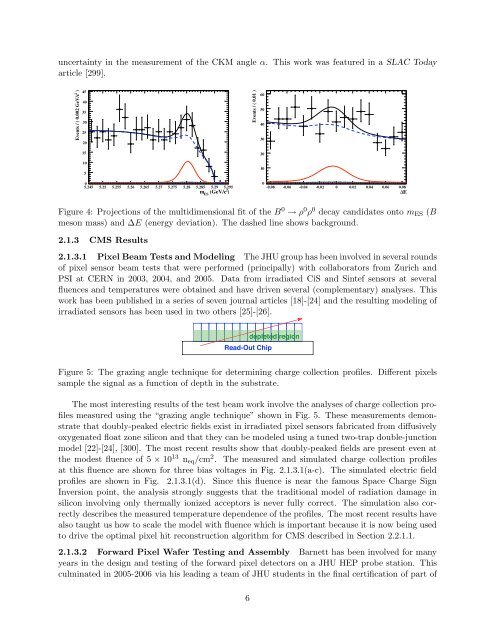proposal2007_draft09.. - Henry A. Rowland Department of Physics ...
proposal2007_draft09.. - Henry A. Rowland Department of Physics ...
proposal2007_draft09.. - Henry A. Rowland Department of Physics ...
You also want an ePaper? Increase the reach of your titles
YUMPU automatically turns print PDFs into web optimized ePapers that Google loves.
uncertainty in the measurement <strong>of</strong> the CKM angle α. This work was featured in a SLAC Today<br />
article [299].<br />
Events / ( 0.002 GeV/c 2 )<br />
45<br />
40<br />
35<br />
30<br />
25<br />
20<br />
Events / ( 0.01 )<br />
60<br />
50<br />
40<br />
30<br />
15<br />
10<br />
5<br />
0<br />
5.245 5.25 5.255 5.26 5.265 5.27 5.275 5.28 5.285 5.29 5.295<br />
2<br />
(GeV/c )<br />
m ES<br />
20<br />
10<br />
0<br />
-0.08 -0.06 -0.04 -0.02 0 0.02 0.04 0.06 0.08<br />
DE<br />
Figure 4: Projections <strong>of</strong> the multidimensional fit <strong>of</strong> the B 0 → ρ 0 ρ 0 decay candidates onto m ES (B<br />
meson mass) and ∆E (energy deviation). The dashed line shows background.<br />
2.1.3 CMS Results<br />
2.1.3.1 Pixel Beam Tests and Modeling The JHU group has been involved in several rounds<br />
<strong>of</strong> pixel sensor beam tests that were performed (principally) with collaborators from Zurich and<br />
PSI at CERN in 2003, 2004, and 2005. Data from irradiated CiS and Sintef sensors at several<br />
fluences and temperatures were obtained and have driven several (complementary) analyses. This<br />
work has been published in a series <strong>of</strong> seven journal articles [18]-[24] and the resulting modeling <strong>of</strong><br />
irradiated sensors has been used in two others [25]-[26].<br />
depleted region<br />
Read-Out Chip<br />
Figure 5: The grazing angle technique for determining charge collection pr<strong>of</strong>iles. Different pixels<br />
sample the signal as a function <strong>of</strong> depth in the substrate.<br />
The most interesting results <strong>of</strong> the test beam work involve the analyses <strong>of</strong> charge collection pr<strong>of</strong>iles<br />
measured using the “grazing angle technique” shown in Fig. 5. These measurements demonstrate<br />
that doubly-peaked electric fields exist in irradiated pixel sensors fabricated from diffusively<br />
oxygenated float zone silicon and that they can be modeled using a tuned two-trap double-junction<br />
model [22]-[24], [300]. The most recent results show that doubly-peaked fields are present even at<br />
the modest fluence <strong>of</strong> 5 × 10 13 n eq /cm 2 . The measured and simulated charge collection pr<strong>of</strong>iles<br />
at this fluence are shown for three bias voltages in Fig. 2.1.3.1(a-c). The simulated electric field<br />
pr<strong>of</strong>iles are shown in Fig. 2.1.3.1(d). Since this fluence is near the famous Space Charge Sign<br />
Inversion point, the analysis strongly suggests that the traditional model <strong>of</strong> radiation damage in<br />
silicon involving only thermally ionized acceptors is never fully correct. The simulation also correctly<br />
describes the measured temperature dependence <strong>of</strong> the pr<strong>of</strong>iles. The most recent results have<br />
also taught us how to scale the model with fluence which is important because it is now being used<br />
to drive the optimal pixel hit reconstruction algorithm for CMS described in Section 2.2.1.1.<br />
2.1.3.2 Forward Pixel Wafer Testing and Assembly Barnett has been involved for many<br />
years in the design and testing <strong>of</strong> the forward pixel detectors on a JHU HEP probe station. This<br />
culminated in 2005-2006 via his leading a team <strong>of</strong> JHU students in the final certification <strong>of</strong> part <strong>of</strong><br />
6
















